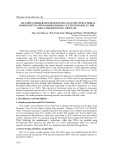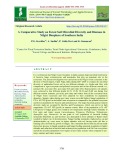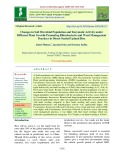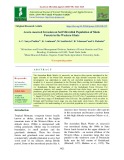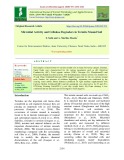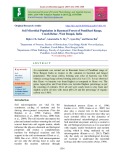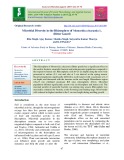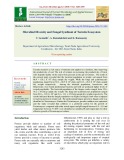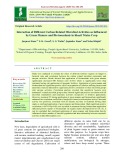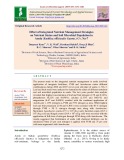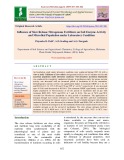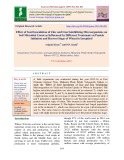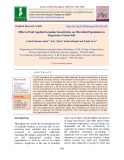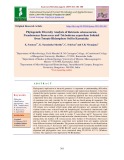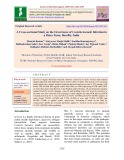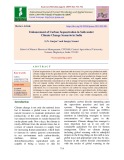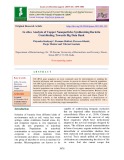
Bacterial population in soil
-
Fungal and bacterial rhizosphere microbiome associated with selected melon and snake melon genotypes
The total bacterial population in the rhizosphere of ten melon and two snake melon genotypes was significantly 59 to 68% higher than control soil. For most tested genotypes, a significant increase in the culturable rhizospheric actinomycetes, about 28.5 to 92.6%, was recorded comparatively to control soil. Fungal population counts in the rhizosphere of tested genotypes were significantly comparable to control.
 7p
7p  mudbound
mudbound
 10-12-2021
10-12-2021
 10
10
 1
1
 Download
Download
-
In the past decades, next generation sequencing has improved our understanding of bacterial diversity in soil (Simon and Daniel, 2011). Nguyen et al. (2016) used 454 pyrosequencing to detect bacterial community in Korean ginseng cultivated soil in Korea. But the high cost of 454 pyrosequencing tools have limited small laboratories‟ access. Due to that, in 2001 Illumina developed MiSeq which have enabled deep sequencing of microbial communities at a lower cost (Caporaso et al., 2012).
 9p
9p  nguathienthan11
nguathienthan11
 06-04-2021
06-04-2021
 14
14
 2
2
 Download
Download
-
The conclusion drawn from the present study showed an increase in fungal population and fungal feeding nematode population at higher altitudes and reduction in bacterial and actinomycetes population in all the four ecosystems and all the microbial population were highest in post rainy seasons when compared to prerainy, summer and winter seasons.
 15p
15p  trinhthamhodang9
trinhthamhodang9
 16-12-2020
16-12-2020
 12
12
 1
1
 Download
Download
-
A field experiment was carried out at Assam Agricultural University, Jorhat (Assam) in direct seeded rice (DSR) during autumn, 2018. The treatments consisted of three Plant growth-promoting rhizobacteria (PGPR) inoculations viz., Bacillus cereus, Pseudomonas fluorescens and no inoculation and four weed management practices viz., pretilachlor pre-emergence @ 0.75 kg/ha, pretilachlor pre- emergence @ 0.75 kg/ha followed by one hand weeding at 30 DAS, three hand weedings at 15, 30 & 45 DAS and weedy check.
 7p
7p  trinhthamhodang1215
trinhthamhodang1215
 23-09-2020
23-09-2020
 11
11
 1
1
 Download
Download
-
The study showed a significant variation in the microbial population in the different study plots with the highest bacterial (29.3 x108 cfu g1 ), fungal (15.0 x104 cfu g-1 ) and actinomycetes (3.0 x103 cfu g-1 ) population in shola forest in all the three ranges of Kodaikanal Forest Division. The population of soil microbes in Berijam and Poombarai forest range was also high under shola forests. This study has contributed to the understanding of soil microbial population in A. mearnsii invaded shola forests.
 5p
5p  trinhthamhodang1215
trinhthamhodang1215
 23-09-2020
23-09-2020
 4
4
 1
1
 Download
Download
-
Soil samples collected from two termite mound soils in Anna University campus, Chennai, Tamil Nadu were characterized for the various parameters such as pH, Electrical Conductivity (EC), Total organic carbon (TOC), Nitrogen (N), Phosphorus(P) and Potassium (K)and microbial activity. The dehydrogenase enzyme activity was found to be 25 and 23mg TriphenylFormosan (TPH) mg/g/h respectively for the two termite mound soils.
 8p
8p  kethamoi7
kethamoi7
 26-08-2020
26-08-2020
 17
17
 2
2
 Download
Download
-
An experiment was carried out in Rasomati forest of Pundibari range of West Bengal, India in respect to the variation in bacterial and fungal populations. The mean colony forming unit (cfu) of bacteria was 6.02 whereas average fungi colony forming unit (cfu) was 5.31. It was observed that Gram -ve bacteria was found higher as compared to Gram +ve. The genus Aspergillus and Penicillium was recorded highest percentage as per the counting of colonies. Over all soil were sandy loam to clay loam and slightly acid in all sites with mean pH 6.24 and the percentage of organic carbon was 1.96%.
 7p
7p  angicungduoc6
angicungduoc6
 20-07-2020
20-07-2020
 10
10
 2
2
 Download
Download
-
The rhizosphere of Momordica charantia (Bitter gourd) has a significant effect on the aerobic bacteria, anaerobic bacteria and actinomycetes population compared to the respective barren soil. Rhizospheric soils (0–25 cm depth) along the roots were processed at surface (0-1 cm) and also at 5 cm interval in the spring season. Bacterial population significantly differed in each transect with a maximum at 1–5 cm depth, and decreased with the increase in the root length. Rhizosheric region (20–25 cm) exhibited maximum R/S ratio (rhizospheric effect).
 10p
10p  nguaconbaynhay6
nguaconbaynhay6
 24-06-2020
24-06-2020
 8
8
 0
0
 Download
Download
-
Termite mound is a rich source of nutrients and applied as a fertilizer, thus improving the productivity of soil. The role of termites in increasing the productivity of forest soils depends mainly on the micro flora presents in the gut of termites. The result of the present study revealed that the bacterial population in termite soil ranged from 68.4 – 138.2 X 106 cfu/g sample dry weight.
 13p
13p  nguaconbaynhay6
nguaconbaynhay6
 23-06-2020
23-06-2020
 8
8
 0
0
 Download
Download
-
Study was conducted to evaluate the effect of different fertilizer regimes on fungal to bacterial ratio and correlation between the carbon related microbial community and enzyme activities. Result showed that application of bioinoculant with green manure significantly decreased F/B biomass ratio (0.441) which is significantly lower than treatment having sole application of inorganic fertilizer.
 9p
9p  chauchaungayxua4
chauchaungayxua4
 18-03-2020
18-03-2020
 18
18
 1
1
 Download
Download
-
The present study on the integrated nutrient management in aonla involved application of inorganic fertilizers, FYM and Azotobacter under different combinations during 2016 and 2017 on ten year old plant of aonla cv. NA-7. Leaf and fruit study were analyzed to determine the status of different nutrients and soil microbial population in aonla. The two years pooled data analysis revealed that highest concentration of leaf and fruit nitrogen (2.78 and 0.14%), phosphorous (0.22% and 0.030%), calcium (2.33% and 0.031%) and magnesium (0.47 and 0.
 10p
10p  caygaocaolon3
caygaocaolon3
 09-03-2020
09-03-2020
 18
18
 0
0
 Download
Download
-
An Incubation study under laboratory condition were conducted during 2015-16 with a view to study “Influence of slow release nitrogenous fertilizers on soil enzyme activity and microbial population under laboratory condition” The laboratory incubation experiment was conducted in completely randomized design. In incubation study, the urease enzyme activity was increased with an increased period of incubation in all the treatments. Dehydrogenase enzyme activity was significantly higher in treatment GRDF at 7, 21, 45 and 90 DAA (1.41, 1.55, 1.69 and 1.56 µg TPF g-1 soil hr-1 respectively).
 11p
11p  trinhthamhodang3
trinhthamhodang3
 12-02-2020
12-02-2020
 16
16
 0
0
 Download
Download
-
Combined soil application of Bio NPK and pesticides either simultaneous and sequential can enhanced plant growth parameters effectively and most of the pesticides tested viz. Profenofos 50% EC, Spinosad 45% SC, Dichlorvos 76% EC, Imidacloprid 30.5% EC, Fipronil 5% SC, Chlorpyrifos 20% EC, Pyraclotrobin 20% WG, Ridomil 68% WP, Quizalofop 5% EC and Finoxaprop 9% EC found safe to beneficial bacteria at the field recommended dose exhibiting no reduction of bacterial population compared with untreated control.
 9p
9p  chauchaungayxua3
chauchaungayxua3
 07-02-2020
07-02-2020
 23
23
 1
1
 Download
Download
-
A field experiment was conducted during the year 2015-16 at Post Graduate Institute Farm, Mahatma Phule Krishi Vidyapeeth, Rahuri, to study the “Effect of Seed Inoculation of Zinc and Iron Solubilizing Microorganisms on Yield and Nutrient Uptake of Wheat in Inceptisol. The highest microbial population was also observed in treatment T7, which was at par with treatment T6 and T5, in panicle initiation and harvest stage, with a slight decline at the harvest stage of wheat.
 8p
8p  kethamoi2
kethamoi2
 15-12-2019
15-12-2019
 13
13
 0
0
 Download
Download
-
A field experiment was conducted at Main Sugarcane Research Station Farm of Navsari Agricultural University, Navsari. Four treatment of insecticides viz. T0 Control, T1 Phorate 10G (1.5 kg a.i./ha), T2 Carbofuran 3G (1 kg a.i./ha), T3 Chloran traniliprole 0.4G (0.1 kg a.i./ha) were taken and applied at 60 days after planting. The soil samples were periodically collected at 1, 10, 30, 60 days after application of phorate and at the time of harvest and analyzed on the same day by serial dilution technique.
 6p
6p  kequaidan2
kequaidan2
 13-12-2019
13-12-2019
 20
20
 1
1
 Download
Download
-
Phylogenetic implication in bacterial genomics is important to understanding difficulties such as population history, antimicrobial resistance and transmission dynamics. It has been claimed that partial genome sequences would clarify phylogenetic relationships between isolated organisms, but up to now, no sustaining approach has been proposed to use competently these data. concatenation of sequences of different genes as well as building of consensus trees only consider the few genes that are shared among all organisms.
 8p
8p  kequaidan2
kequaidan2
 11-12-2019
11-12-2019
 25
25
 0
0
 Download
Download
-
Q fever is highly infectious bacterial zoonoses caused by Coxiella burnetii and remains largely neglected and underreported in various states of India. The present cross-sectional study employing a simple random sampling approach analysed a total of 324 samples (108 blood, 108 sera and 108 vaginal swabs) from cattle (n=108) employing of PCR and ELISA of cattle dairy farm from Bareilly, Uttar Pradesh, India. Besides, 18 environmental samples (animal feed-05, soil-04, drainage water-05 and drinking water-04) from the premises of the farm were also collected.
 6p
6p  cothumenhmong1
cothumenhmong1
 08-12-2019
08-12-2019
 9
9
 1
1
 Download
Download
-
An experiment was conducted to study the bio-efficacy of native bioagent and biofertilizer for the management of root-knot nematode Meloidogyne incognita infecting black gram Vigna mungo. For this the bioagents, Pseudomonas fluorescens, Bacillus megaterium, Pochonia chlamydosporia and Purpureocillium lilacinum and biofertilizers like Azotobacter sp. and Rhizobium sp. were screened against M. incognita by using seed treatment under pot condition.
 18p
18p  cothumenhmong1
cothumenhmong1
 08-12-2019
08-12-2019
 21
21
 0
0
 Download
Download
-
Carbon sequestration is the most important and necessary for good crop production under climate change from the agricultural soils. The increase in gaseous concentration of carbon dioxide, methane and various other gases results decreased crop production, change in soil chemical and biological properties like soil texture, soil structure, soil organic matter content and elemental concentration as well as change in bacterial and fungal populations.
 8p
8p  cothumenhmong1
cothumenhmong1
 08-12-2019
08-12-2019
 12
12
 1
1
 Download
Download
-
16S rRNA gene sequences are most commonly used for determination or studying the bacterial phylogeny and taxonomy because its present in almost all bacterial population. 16S rRNA gene sequence is remaining conversed during evolution so that 16S rRNA gene identification method is widely used for identification of bacterial diversity. In this study, bacterial population was isolated from soil sample for copper nanoparticles synthesis and maximum copper synthesizing bacteria further used for characterization.
 6p
6p  nguaconbaynhay1
nguaconbaynhay1
 04-12-2019
04-12-2019
 27
27
 1
1
 Download
Download
CHỦ ĐỀ BẠN MUỐN TÌM









